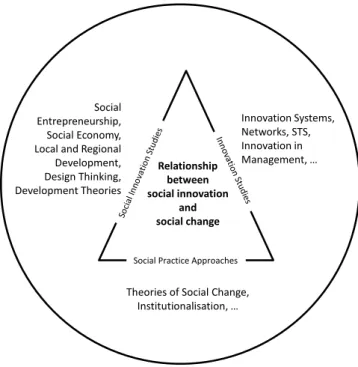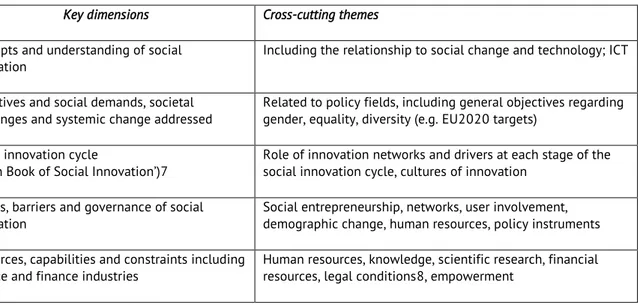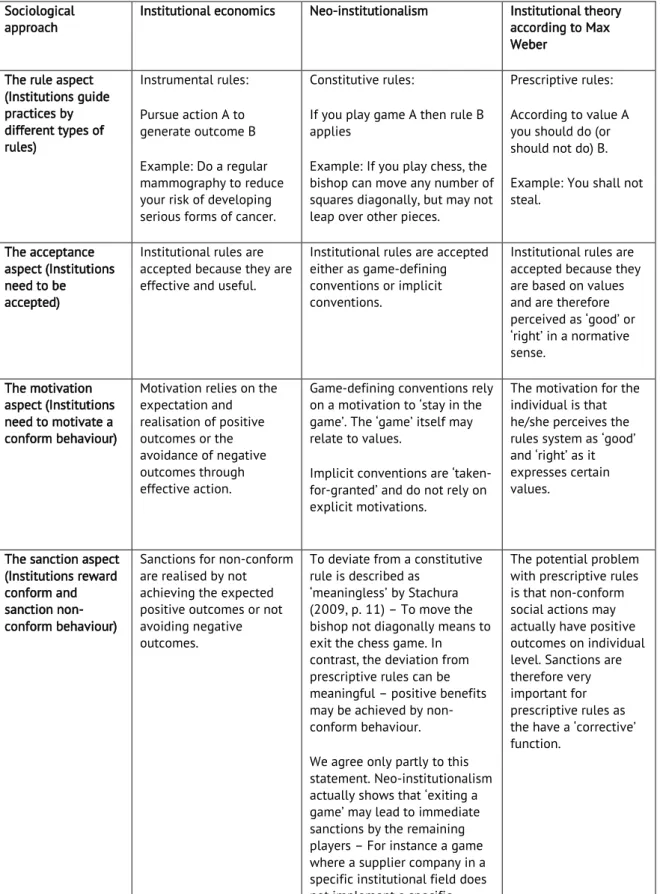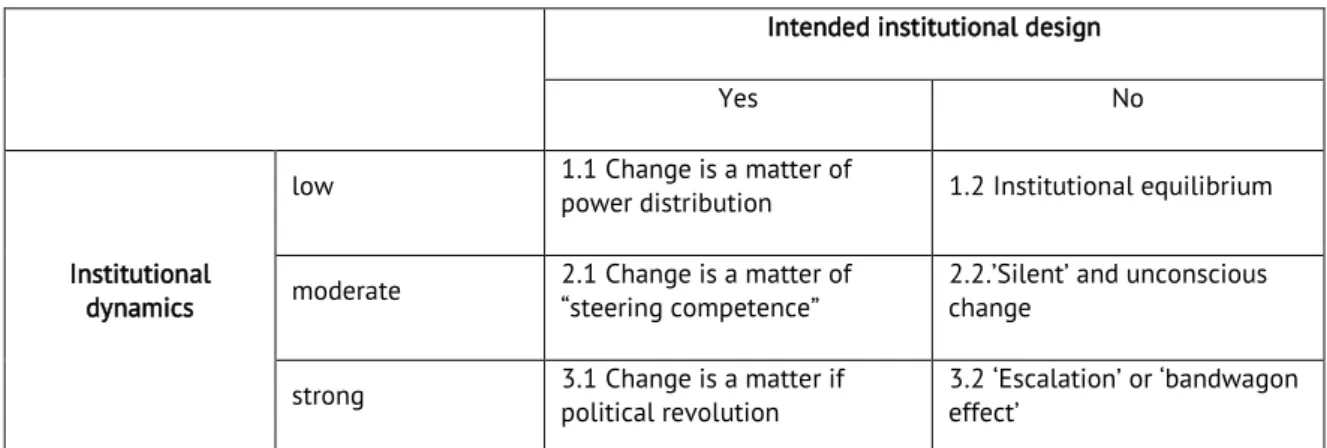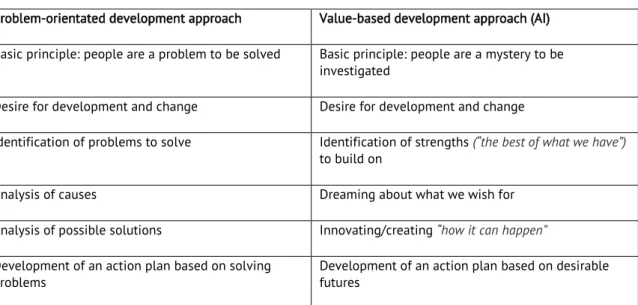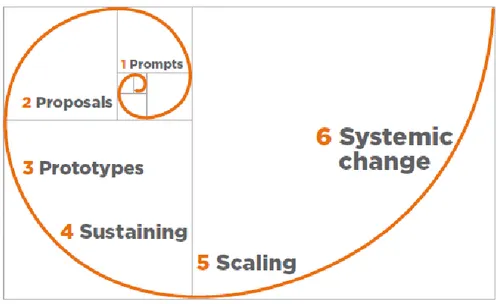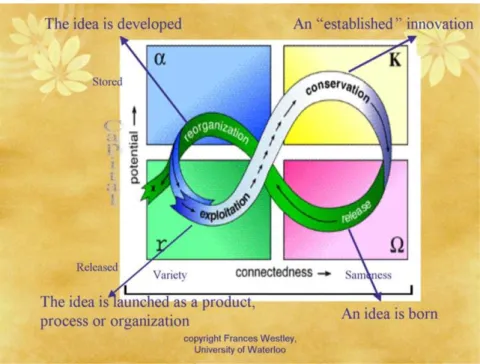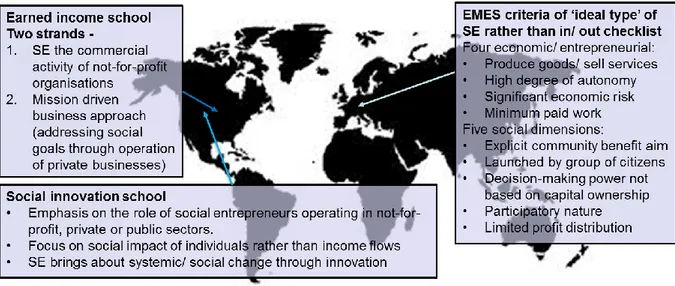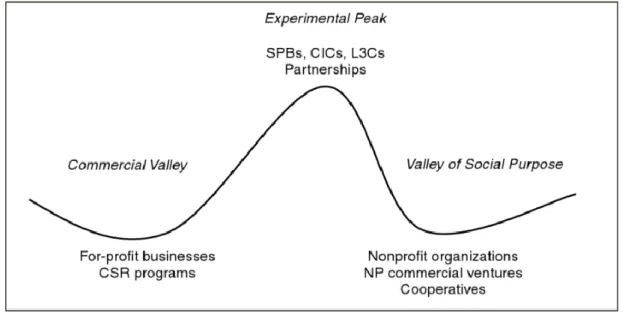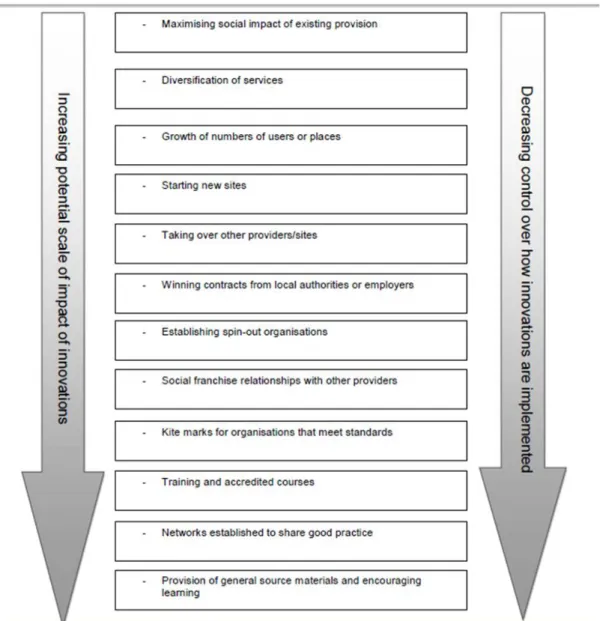THEORETICAL APPROACHES TO SOCIAL INNOVATION
–
A CRITICAL LITERATURE REVIEW
September 2014
This project has received funding from the European Union‖s Seventh Framework Programme for research, technological development and demonstration under grant agreement no 612870.
Acknowledgements
We would like to thank all authors of this critical literature review and all partners of the SI-DRIVE consortium for their comments and contributions to this paper. Also many thanks to Steven Dhondt, Beatriz Pérez de las Heras and Matthias Weber as members of SI-DRIVE‖s Quality Review Board for their valuable feedback. We also thank Theresa Baumeister for her support.
Suggested Citation
Howaldt, J., Butzin, A., Domanski, D., & Kaletka, C. (2014). Theoretical Approaches to Social Innovation - A Critical Literature Review. A deliverable of the project: ‘Social Innovation: Driving Force of Social Change’ (SI-DRIVE).
Dortmund: Sozialforschungsstelle.
SI-DRIVE
‘Social Innovation: Driving Force of Social Change’ (SI-DRIVE) is a research project funded by the European Union under the 7th Framework Programme. The project consortium consists of 25 partners, 15 from the EU and 10 from world regions outside the EU. SI-DRIVE is led by TU Dortmund / Sozialforschungsstelle and runs from 2014-2017.
Editors: Jürgen Howaldt, Anna Butzin, Dmitri Domanski, Christoph Kaletka
Authors: Anna Butzin, Anna Davies, Dmitri Domanski, Steven Dhondt, Jürgen Howaldt, Christoph Kaletka, Alexander Kesselring, Ralf Kopp, Jeremy Millard, Peter Oeij, Dieter Rehfeld, Petra Schaper-Rinkel, Michael Schwarz, Anette Scoppetta, Petra Wagner- Luptacik, Matthias Weber
Lead partner: TU Dortmund
Date: September 2014
CONTENTS
1 Introduction... 1
Theories of Social Change 2 Social Theory ... 9
2.1 Introduction ...9
2.2 State of the art of social innovation and social change ... 10
2.3 Social practice theory (SPT) ... 12
2.3.1 The relevance of Gabriel Tarde‖ social theory ... 15
2.3.2 Approaches with recourse to the analytical programme of Gabriel Tarde ... 18
2.4 Institutions as ―rule systems‖ guiding social practice ... 21
2.4.1 Degrees of institutionalisation ... 24
2.4.2 Institutional design and institutional dynamics ... 25
2.5 Conclusion ... 26
3 Development Theory ... 34
3.1 Introduction and overview ... 34
3.1.1 Definitions of development ... 34
3.1.2 Development research and social innovation ... 34
3.1.3 The development challenge ... 35
3.1.4 Purpose and structure of this chapter ... 36
3.2 State of the art ... 36
3.2.1 Development theory and its relevance for social innovation ... 36
3.2.2 Innovation theories in development contexts ... 43
3.2.3 Concepts and approaches to social innovation in development contexts ... 46
3.3 Conclusion ... 49
Social Innovation Studies 4 Social Innovation Process and Social Entrepreneurship ... 60
4.1 Introduction ... 60
4.2 The social innovation life-cycle ... 60
4.3 Social enterprise and social entrepreneurship ... 63
4.3.1 Social enterprise and social entrepreneurship: unpacking schools of thought ... 63
4.3.2 The distinctive features of social enterprise ... 66
4.3.3 Social entrepreneurship and scaling ... 67
4.3.4 Social entrepreneurship and the relationship to transformative social change ... 71
4.3.5 Critical turn in social entrepreneurship scholarship ... 72
4.4 Conclusion ... 73
5 Social Innovation in the Social Economy and Civil Society ... 79
5.1 Introduction ... 79
5.2 Historical perspective ... 79
5.3 Social innovation in the social economy ... 80
5.3.1 Understanding the social economy concept ... 80
5.3.2 Social economy and its relation to social innovation ... 81
5.3.3 Contributions of social innovations in the social economy ... 82
5.3.4 Potentials for social innovations in the social economy ... 83
5.4 Social innovation in the civil society ... 83
5.4.1 Civil society ... 84
5.4.2 Empowerment ... 85
5.4.3 Social movements ... 86
5.4.4 Spatial development ... 87
5.5 Social innovation in the social economy and civil society and its relationship to social change ... 89
5.6 Conclusion ... 90
6 Design Thinking ... 97
6.1 Introduction: Design thinking & social innovation ... 97
6.2 Innovation as practice in design thinking ... 98
6.3 Objectives of innovation & models of innovation dynamics ... 99
6.4 Drivers, barriers, capabilities and constraints of social Innovation ... 100
6.5 Conclusion ... 101
Innovation and Management Studies 7 Innovation Studies ... 105
7.1 Introduction ... 105
7.2 Building blocks and achievements on innovation studies in the light of the key dimensions of SI- DRIVE ... 106
7.2.1 Innovation systems ... 108
7.2.2 Innovation networks ... 110
7.2.3 Actors and functions of actors ... 111
7.2.4 Knowledge and innovation ... 112
7.2.5 Geographical context of innovation ... 112
7.2.6 Dynamics of innovation ... 113
7.3 Conclusion and relation to social change... 114
8 Social Innovation related to Innovation in Management Studies ... 122
8.1 Introduction ... 122
8.2 From closed to open innovation ... 123
8.3 New organisations and ways of innovating: theories on management ... 125
8.3.1 Management as designers ... 125
8.3.2 Management technology and dynamic capabilities ... 126
8.3.3 Knowledge economy and absorptive capacity ... 127
8.4 Risk management ... 128
8.4.1 Open innovation ... 128
8.4.2 Two innovation management models ... 131
8.4.3 Making idiosyncratic combinations ... 134
8.4.4 A note on diffusion of innovation ... 136
8.5 Policy and business innovation ... 137
8.6 Conclusion and discussion ... 140
9 Conclusions ... 151
9.1 General remarks ... 151
9.2 Key lessons learned and research questions ... 151
9.2.1 Concepts and understanding of innovation ... 151
9.2.2 Objectives and social demands, societal challenges and systemic change addressed ... 152
9.3 Process dynamics ... 153
9.3.1 Processes of institutionalisation ... 153
9.3.2 Social change ... 153
9.4 Governance, actors, drivers and barriers ... 154
9.4.1 Governance ... 154
9.4.2 Actors... 155
9.4.3 Drivers and barriers of social innovation ... 155
9.5 Resources, capabilities and constraints ... 156
9.6 Summary and outlook ... 157
9.6.1 Summary ... 157
9.6.2 Outlook ... 160
1
1 INTRODUCTION
Jürgen Howaldt (TUDO)
The theory of innovation has a long history dating back to the pioneering work of Schumpeter (2006) in the early 20th century. While much of the early theoretical work emphasised the socio-cultural dimensions of innovation (Kallen, 1932; and other relevant predecessors like Tarde, 1903 and Ogburn, 1966), this was gradually displaced in favour of more economic and technological perspectives. Recently, however, there has been a revival. The concept of social innovation is becoming increasingly evident in policy, scientific and public debates. There is a growing consensus among practitioners, policy makers and the research community that widespread social innovation is required to cope with the significant challenges that societies are facing now and in the future.
The momentum for this revival is being driven by new projects, initiatives, methods and efforts to establish innovation. The field is practice led. And, as Mulgan (2012) has outlined, while there are many theoretical foundations which help to conceptualise the field, there is not yet a consistent theoretical foundation of social innovation.
Against this background, the European Commission is funding a large scale research project called SI-DRIVE
1. The main objectives of the project are (1) an integration of theories and research methodologies to advance understanding of SI, (2) a European and global mapping of SI, addressing different social, economic, cultural, historical and religious contexts in eight major world regions, and (3) feedback to and discussion with policy makers and practitioners on the basis of in-depth analysis and case studies in seven policy fields. An overarching research question is how social innovation relates to social change.
2In order to provide a solid answer to this question, the project will contribute to the establishment and communication of a theoretical understanding of social innovation, as well as to methodologies, skills and tools enabling analysis and identification of, creation, testing, implementation and sustainability of social innovations.
This document, as the first thematic deliverable of SI-DRIVE, provides a multidisciplinary literature review of existing theoretical and conceptual strands on social innovation and its relationship to social change. Against the background of this review, multidisciplinary hypotheses, research foci and questions are formulated. These will inform especially the upcoming methodological preparations of the empirical mapping of social innovation cases.
A first sketch: Social innovation and social change
Though there is widespread recognition of the need for social innovation, there is no clear understanding of how social innovation leads to social change. Phenomena of social change are often looked at in connection mainly with technological innovation, but without paying sufficient attention to elements of social innovation.
In many areas (including several of those policy fields studied by the SI-DRIVE project such as energy, mobility, health, etc.) the social and the technological dimensions of innovation are strongly inter-connected and can hardly be separated from each other in explaining social change. But there are also examples of social
innovations which are largely independent from technological innovations and which can lead to social change by themselves. Overall, the technology-centred paradigm of explaining social change, shaped by the industrial society, seems outdated and needs to be replaced by a paradigm which assigns appropriate prominence to social innovation and which is able to describe and analyse social innovation as an autonomous field of research on the one hand, but also able to reflect the intimate links between the social and the technical sphere.
And even though social change is a key term of sociology, there is a multitude of definitions regarding its content. Following a generic definition resonating in several other definitions at later stages, social change can be understood as the plethora of changes in the institutional structure of a society in a given time frame (Heintz, 1958). Whether this structure as the subject of change is considered a value system from a structural functionalism perspective, a hierarchic shift from a perspective of conflict theory, of a change in social
1 www.si-drive.eu
2 The term social change is being used as an umbrella term in this report. Its relation to systemic change (addressing change in a defined social system), or transformative social change (implying opportunities to intentionally bring about change) is one of the objectives of SI-DRIVE.
2
relations, is both a matter of research interest and a corresponding theoretical approach (Jäger & Weinzierl, 2007). SI-DRIVE‖s predominant interest lies in a better understanding of social innovation as a mechanism of change at the micro- and meso-level on the one hand and its relation and contribution to social change on the macro-level
3, cumulatively described by Zapf as a ‘process of change in the social structure of a society in its constitutive institutions, cultural patterns, associated social actions and conscious awareness’ (Zapf, 2003, p. 427).
Whereas – mainly based on Ogburn‖s theory – a specialised sociology of change has developed, social innovation as an analytical category is at best a secondary topic both in the classical and contemporary social theory approaches (Schäfers, 2002). Apart from a few exceptions (in particular Hochgerner, 2009; Mulgan, 2012; Harrison, 2012; Howaldt & Schwarz, 2010; Jessop et al., 2013), social sciences largely seem to refuse to label considerable parts of their research objects as social innovations (Rammert, 2010).
Against the background of the emergence of a new innovation paradigm, it is becoming ever more important to devote greater attention to social innovation as a mechanism of change residing at the micro and meso level.
The reasons for this are obvious. First, the shortcomings of older models of social change and of an
economically and technologically focused innovation model are becoming increasingly apparent when dealing with today‖s key social challenges. Second, the dissolving power of new forms of governance, participation and self-help, protest movements and new social practices – understood as necessary social innovations – are becoming ever more apparent.
In the context of the broad social debate surrounding sustainable development and necessary social
transformation processes (WGBU, 2011; Geels & Schot, 2007), the question of the relationship between social innovation and social change is becoming even more pressing. It is, therefore, necessary to analyse the policy and socio-economic environment in order to answer key questions: Why, where and how does social innovation make a difference? What and who drives social innovation? What are the critical factors enabling social innovation to produce sustainable impact and to be scaled up? And how is social innovation shaped, enabled and restricted by institutional frames?
Yet social innovation is still an uncodified field without a common set of theoretical underpinnings, datasets, or proven causal relationships (Howaldt & Schwarz, 2010; Franz et al., 2012). Although there is a growing body of literature on social innovation, the demand for categorizing the field is growing (Rüede & Lurtz, 2012). We currently lack a theoretically sound concept of social innovation beyond the different policy areas, research fields and regional perspectives (Howaldt & Schwarz, 2010; Moulaert et al., 2013, p. 4). There is a need for robust models for the creation, roll out and diffusion of social innovations, as well as more knowledge and understanding about how it relates to social change. A theoretically sound concept of SI is a precondition for the development of an integrated theory of socio-technological innovation in which social innovation is more than a mere requirement, side effect and result of technological innovation. Only by taking into account the unique properties and specifics of social innovation in different contexts, it is possible to comprehend the systemic connection and characteristics of social and technological innovation as driving forces in the overall processes of social change.
Theoretical building blocks of the literature review
As a first step starting from an innovation perspective, the relationship between social innovation and social change shall be approached by three building blocks under which diverse theoretical and conceptual approaches can be subsumed (see figure. 1). These building blocks are:
1. Theories of social change focusing on practice theory, institutionalisation and development theories;
2. Theoretical approaches in the different fields of social innovation research (social entrepreneurship, social economy, local and regional development, design thinking, development studies);
3. Innovations studies including science and technology studies (STS), management and business innovations.
3 See also chapter 2.
3
Figure 1: Theoretical building blocks of the literature review
The rationale for choosing these building blocks is based on the SI-DRIVE working definition of social innovation. According to the working definition, social innovation is a new combination of social practices in certain areas of action or social contexts with the goal of better satisfying or answering social needs and problems than is possible on the basis of existing practices. In this sense, social innovation can be "interpreted as a process of collective creation in which the members of a certain collective unit learn, invent and lay out new rules for the social game of collaboration and of conflict or, in a word, a new social practice, and in this process they acquire the necessary cognitive, rational and organizational skills" (Crozier & Friedberg, 1993, p. 19).
In this sense, social innovations encompass new practices (concepts, policy instruments, new forms of cooperation and organisation,) methods, processes and regulations that are developed and/or adopted by citizens, customers, politicians etc. in order to meet social demands and to resolve societal challenges
4in a better way than existing practices.
The chosen theoretical and conceptual approaches have in common micro and meso scale perspectives which make them appropriate to theoretically and empirically study social innovation. This provides a better understanding of the multiplicity of drivers and initiatives engaged in the process of invention, creation, imitation and adoption of technological and social innovation. Here, it is about a modified understanding of what social behaviour is – compared to action, system and structural theories – and for this reason a modified understanding of ―social‖ as social practices. The latter can be found between routines and incalculability, closeness and openness for change and make a possible view on their reconfiguration as a core element of social innovation.
Accordingly, the literature review is structured as follows: in the building block on social theories of change, first a reflection is made on Gabriel Tarde‖s micro-sociological and ―poststructuralist‖ approach. Within this approach, the terms ―imitation‖, ―invention‖ and ―innovation‖ are central for the understanding of how social innovation contributes to social change (Tarde, 2009). Tarde‖s concept also plays a very important role in
4 Such societal challenges predominantly become manifest on the policy level, with the largest influence potential of non-politicians in the agenda-setting phase. Following the European Commission (2013), the core societal challenges as of today are health, demographic change and wellbeing; food security, sustainable agriculture and forestry, marine and maritime and inland water research, and the bioeconomy; secure, clean and efficient energy; smart, green and integrated transport; climate action, environment, resource efficiency and raw materials; Europe in a changing world - inclusive, innovative and reflective societies;secure societies - protecting freedom and security of Europe and its citizens (http://ec.europa.eu/programmes/horizon2020/en/h2020-section/societal-challenges).
Social Practice Approaches
Innovation Systems, Networks, STS, Innovation in Management, …
Theories of Social Change, Institutionalisation, … Social
Entrepreneurship, Social Economy, Local and Regional Development, Design Thinking, Development Theories
Relationship between social innovation
and social change
4
Latour‖s actor network theory that treats objects as part of social networks (Latour, 2009) (chapter 2). Second, diverse innovation concepts developed within development theories (reverse and frugal innovation) are discussed in a chapter on development theories (chapter 3).
The building block on social innovation theories reflects diverse perspectives on social innovation. It includes discussions on the social innovation life cycle, social entrepreneurship and the issue of scaling (chapter 4), the social economy, civil society and social movements as sources of innovation, the link between social
innovation and local development (chapter 5), as well as a dedicated chapter on design thinking (chapter 6).
The building block on innovation studies includes two chapters. Chapter 7 provides state-of-the-art debates in innovation studies, including reflection on the systemic and networked nature of innovation, the knowledge intensity related to innovation development, as well as evolutionary and transition approaches. Chapter 8 focuses on innovation concepts in management, in particular including the issue of workplace innovation, open innovation and the quadruple helix concept.
5This is followed by a conclusion discussing the future research fields derived from the chapters of the critical literature review.
Points of reference throughout the chapters
For each of the chapters, the main objective is to elaborate research foci, hypotheses and questions for further empirical work. This is done by addressing two points of reference. Firstly, all chapters strive to discuss the following set of questions:
What is the relevance of the theoretical approaches discussed?
What are the next steps in developing a typology of social innovations and a theoretical understanding of social innovation?
What have we learned in relationship to:
o a theoretically sound and comprehensive concept of social innovation and
o the most appropriate conditions for introducing, implementing, diffusing and establishing social innovations?
o the relationship to social change
Second, if appropriate, the chapters refer to key dimensions of social innovation research which affect the potential of social innovations, their scope, and their impact. These are:
1. Concepts and understanding of (social) innovation including the relationship to technology and business innovation;
2. Objectives and social demands, societal challenges and systemic changes that are addressed;
3. Drivers, barriers and governance (including the role of social entrepreneurship, networks, user involvement) of social change and development;
4. Social innovation cycle (prompts, proposal, prototypes, sustaining, scaling up, systemic change)
6;
5. Resources, capabilities and constraints including finance and regulations of the finance industries, human resources, empowerment.
5 The critical literature review (CLR) refers to the state of the art of the debate about social innovation in due consideration of the technological and management innovation research. In this debate there is no political science or historical perspective to find. The critical literature review can carve out these deficits, but they are not deficits of the CRL itself.
6 However, research in SI-DRIVE will not assume that any social innovation can lead to social change. Since the call sets the goal to ask for
―changing societies‖, the social change perspective of social innovations must be thoroughly addressed. But at the same time research will neither disregard the social need and the societal challenges perspectives, nor neglect potential impact that may result already from prompts, proposals or prototypes. The key issue is to identify what makes a difference (Westley & Antadze, 2010).
5
However, it shall be noticed that these key dimensions are starting points to guide the theoretical work. This implies that they are subject to refinement due the course of the project‖s theoretical work. The theoretical and empirical research of SI-DRIVE will be framed around these five key dimensions and connected to the cross- cutting issues as defined in the SI-DRIVE proposal (see table 1). As the key dimensions the cross-cutting themes are a starting point that might be refined due course of the project.
Key dimensions Cross-cutting themes
Concepts and understanding of social innovation
Including the relationship to social change and technology; ICT
Objectives and social demands, societal challenges and systemic change addressed
Related to policy fields, including general objectives regarding gender, equality, diversity (e.g. EU2020 targets)
Social innovation cycle
(―Open Book of Social Innovation‖)7
Role of innovation networks and drivers at each stage of the social innovation cycle, cultures of innovation
Drivers, barriers and governance of social innovation
Social entrepreneurship, networks, user involvement, demographic change, human resources, policy instruments Resources, capabilities and constraints including
finance and finance industries
Human resources, knowledge, scientific research, financial resources, legal conditions8, empowerment
Table 1: Key dimensions and cross-cutting themes
Work process
All chapters have been developed by authors who are experts in the relevant fields. To ensure quality and a common understanding, there have been two working meetings (in Dortmund [GER] and Hoofddorp [NL]) at which the authors discussed their chapters in order to receive feedback. In addition, there have been two review loops, at which the coordinators of the literature review as well as some authors provided written review statements about the chapters that have been integrated by the chapters‖ authors. Finally, the literature review was approved by the SI-DRIVE Quality Review Board.
7 Murray et. al., 2010
8 E.g. from labour law to prevention of large scale tax evasion and rules of stock exchange.
6
References
Crozier, M., & Friedberg, E. (1993). Die Zwänge kollektiven Handelns – Über Macht und Organisation. Frankfurt a.M.: Hain.
European Commission. (2013). Social Innovation Research in the European Union. Approaches, findings and future directions. Retrieved from http://ec.europa.eu/research/social-sciences/pdf/social_innovation.pdf Geels, F. W., & Schot, J. (2007). Typology of sociotechnical transition pathways. Research Policy, 36(3), 399-417.
Heintz, P. (1958). Sozialer Wandel. In R. König (Ed.) Fischer Lexikon Soziologie. Frankfurt a.M.: Fischer.
Hochgerner, J. (2009). Innovation processes in the dynamics of social change. In J. Loudin & K. Schuch (Eds.), Innovation cultures. Challenge and learning strategy (pp. 17-45). Prague: Filosofia.
Howaldt, J. & Schwarz, M. (2010). Social Innovation: Concepts, research fields and international trends. IMO international monitoring. Aachen. Retrieved from http://www.sfs.tu-
dortmund.de/odb/Repository/Publication/Doc/1289/IMO_Trendstudie_Howaldt_Schwarz_englische_Version.pdf Franz, H.-W., Hochgerner, J., & Howaldt, J. (2012). Challenge social innovation. Potentials for Business, Social Entrepreneurship, Welfare and Civil Society. Berlin, New York: Springer.
Jessop, B., Moulaert, F., Hulgård, L., & Hamdouch, A. (2013). Social Innovation reseach: a new stage in innovation analysis? In F. Moulaert, D. MacCullam, A. Mehmood & A. Hamdouch (Eds.), The International Handbook on Social Innovation. Collective action, social learning and transdisciplinary research (pp. 11-130).
Cheltenham: Elgar.
Jäger, W., & Weinzierl, U. (2007). Moderne soziologische Theorie und sozialer Wandel. Wiesbaden: VS Verlag für Sozialwissenschaften.
Kallen, H. (1932). Innovation. In E.R. Seligman & A. Johnson (Eds.), Encyclopaedia of the Social Sciences (Vol. 8., pp. 58-61). London: Macmillan.
Latour, B. (2009). Gabriel Tarde und das Ende des Sozialen. In C. Borch & U. Stäheli (Eds.), Soziologie der Nachahmung und des Begehrens. Materialien zu Gabriel Tarde (pp. 39-61). Frankfurt a. M.: Suhrkamp.
Moulaert, F., MacCallum, D., Mehmood, A., & Hamdouch, A. (2013). The International Handbook on Social innovation. Collective action, social learning and transdisciplinary research. Cheltenham: Elgar.
Mulgan, G. (2012). Social Innovation Theories: Can Theory Catch Up with Practice? In H.-W. Franz, J.
Hochgerner & J. Howaldt (Eds.), Challenge Social Innovation. Potentials for Business, Social Entrepreneurship, Welfare and Civil Society (pp. 19-42). Berlin, New York: Springer.
Murray, R., Caulier-Grice, J., & Mulgan, G. (2010). The open book of social innovation, Social innovator series: Ways to design, develop and grow social innovation. The Young Foundation: London.
Ogburn, W. F. (1966). Social Change with Respect to Culture and Original Nature (1
sted. 1922). Oxford: Delta Books.
Rammert, W. (2010). Die Innovationen in der Gesellschaft. In J. Howaldt & H. Jacobsen (Eds.), Soziale Innovation.
Auf dem Weg zu einem postindustriellen Innovationsparadigma (pp. 21-52). Wiesbaden: VS Verlag für Sozialwissenschaften.
Rüede, D., & Lurtz, K. (2012). Mapping the various meanings of social innovation: Towards a differentiated
understanding of an emerging concept. EBS Business School, Research Paper Series 12-03. Retrieved from
http://papers.ssrn.com/sol3/papers.cfm?abstract_id=2091039
7
Schäfers, B. (2002). Sozialstruktur und sozialer Wandel in Deutschland. Stuttgart: Lucius & Lucius.
Tarde, G. (2009). Die Gesetze der Nachahmung. Frankfurt a. M.: Suhrkamp.
Tarde, G. (1903). The law of imitation. New York: Henry Holt and Company.
Westley, F., & Antadze, N. (2010). Making a difference: strategies for scaling social innovation for greater impact. The Innovation Journal: The Public Sector Innovation Journal, 15(2), 2-19.
WBGU. (2011). Welt im Wandel. Gesellschaftsvertrag für eine Große Transformation. Zusammenfassung für Entscheidungsträger. Berlin.
Zapf, W. (2003). Sozialer Wandel. In B. Schäfers (Ed.), Grundbegriffe der Soziologie (pp. 427-433). Opladen: Leske
+ Budrich.
8
THEORIES OF SOCIAL CHANGE
9
2 SOCIAL THEORY
Jürgen Howaldt (TUDO), Alexander Kesselring (ZSI), Ralf Kopp (TUDO), Michael Schwarz (TUDO)
2.1 INTRODUCTION
In light of the increasing importance of social innovation the literature review focuses on a theoretically sound concept of social innovation as a precondition for the development of an integrated theory of socio-
technological innovation. This theoretical concept considers social innovation more than a mere appendage, side effect and result of technological innovation. Only by taking into account the unique properties and specifics of social innovation it will be possible to understand the systemic connection and interdependence of social and technological innovation processes and analyse the relationship between social innovation and social change.
Given the fact that social theory doesn‖t play an important role in social innovation research (Howaldt &
Schwarz, 2010; Mulgan, 2012; Moulaert, Martinelli, Swyngedouw, & Gonzalez, 2013; European Commission, 2013), its possible contributions have to be explored. The scientific discussion on social innovation is polarised between an actor centred, individualistic, attitude orientated perspective on the one hand and an (implicit) structuralistic perspective on the other hand. Social innovations are either attributed to individualistic acts, or considered a deterministic result of external context (Cajaiba-Santana, 2013; European Commission, 2013).
The SI-DRIVE approach defines social innovation as a new combination
9or figuration of practices in areas of social action, prompted by certain actors or constellations of actors with the goal of better coping with needs and problems than is possible by using existing practices. An innovation is therefore social to the extent that it varies social action, and is socially accepted and diffused in society (be it throughout society, larger parts of it, or only in certain societal sub-areas). Depending on circumstances of social change, interests, policies and power, social ideas as well as successfully implemented social innovations may be transformed and ultimately institutionalised as regular social practice or made routine.
If we define social innovation ‘as a new combination or figuration of ―practices‖ (…) transformed and ultimately
―institutionalized‖ as regular social practice’ an integrated approach can be found in recent social theory with its focus on social practices and dynamics of change on the one hand and institutional theories on the other hand.
In the conclusion of their paper analysing definitions of social innovation from various disciplines, Rüede and Lurtz (2012, p. 30) see high potential for future research in practice theory. And Cajaiba-Santana (2013)
‘presents a new conceptual framework to investigate social innovation as a driver of social change’ (p. 1) by linking this approach to institutional theories. Against this background, especially these two approaches have to be explored.
It will be shown that the relation between social innovation and social change still is a quite marginalised topic in social theory approaches. Ogburn‖s concept, which has remained largely misinterpreted in a setting in which there was a one-sided focus on the sociology of technology, could build the basis for a comprehensive theory of innovation. Social practice theories on the one hand and institutional theories on the other hand provide developable potential with the central research question of SI-DRIVE in mind. Tarde‖s theory of imitation delivers important insights for exploring the drivers of social change. This recourse enables fruitful links to social practice theory as well as to approaches of institutionalisation processes.
Referring to the ―practice turn‖ in the field of social sciences (Schatzki, Knorr-Cetina & Savigny, 2001; Reckwitz, 2003), practice theories are an important component of a theory of social innovation (Howaldt & Schwarz, 2010, p. 53f.). In this sense, social innovation can be "interpreted as a process of collective creation in which the members of a certain collective unit learn, invent and lay out new rules for the social game of collaboration and of conflict or, in a word, a new social practice, and in this process they acquire the necessary cognitive, rational and organizational skills" (Crozier & Friedberg, 1993, p. 19). Social innovations encompass new practices (concepts, policy instruments, new forms of cooperation and organisation) methods, processes and regulations that are
9 The term relates to the Schumpeterian terminology defining innovations as ‘new combinations of production factors’ (Howaldt & Schwarz, 2010; Hochgerner, 2012).
10
developed and/or adopted by citizens, customers, politicians etc. in order to meet social demands and to resolve societal challenges in a better way than existing practices.
This perspective on social innovation enables us to better understand the multiplicity of drivers and initiatives engaged in the process of invention, creation, imitation and adopting technical and social innovation. What we are talking about here is – in comparison to action, system and structural theories – a modified understanding of what social behaviour is and, for this reason, also of the ―social‖ as social practices (Shove, Pantzar & Watson, 2012). These can be found between routines and incalculability, closeness and openness for change. They open up a perspective on their reconfiguration as a core element of social innovation.
In this perspective, it becomes more important to devote greater attention to social innovation as a mechanism of change residing at the micro and meso level. A very important theoretical point of reference is Gabriel Tarde‖s micro-sociological and poststructuralist approach. Within this approach, the terms ―imitation‖,
―invention‖ and ―innovation‖ are central for the understanding of how social innovation contributes to systemic social change (Tarde, 2009a). Tarde‖s concept also plays a very important role in Latour‖s actor-network theory that treats objects as parts of social networks (Latour, 2009). This opens up a new integrative perspective on the relationship between technological and social innovation.
Social innovation is consequently the establishment of a new institution guiding new forms of social practice, often coinciding with the disruption of existing institutions. Institutions are rule systems which reproduce social practices (relatively) independent from individual persons, time and space (Giddens, 1984). The term institution thus denotes the long-term stability of a social practice. With Giddens we can say that institutions as structural elements enable and restrict social practices. Institutions are reproduced by conform behaviour often in the form of non-questioned routines and may be challenged by non-conform behaviour. Institutions usually are connected to mechanisms which either reward conform behaviour or sanction non-conform behaviour.
Berger and Luckmann (1980) emphasised the fact that social practices become institutions when passed from one generation to the next in the process of socialisation. What once may have been a result of power struggle or negotiation and consensus making becomes unquestioned and in its concrete history intransparent routine behaviour. It is clear that a social practice does not become an institution from one day to the other. There must be a process of institutionalisation which comprises different ―layers‖ and may be expressed in different
―degrees‖ of institutionalisation. Institutions are not an end-state – they still rely on reproduction, they may
―silently‖ change or they may be challenged by individuals and groups. And finally, institutionalisation and de- institutionalisation are parallel processes – new social practices relate to existing social practices. Newly institutionalised practices may challenge and finally substitute existing institutionalised practices.
Institutionalisation and de-institutionalisation are therefore key concepts to describe the dynamics of social change.
Practice theory approaches and especially Tarde‖s concept of imitation provide important insights for analysing the processes of institutionalisation and how practices are created and institutionalised.
2.2 STATE OF THE ART OF SOCIAL INNOVATION AND SOCIAL CHANGE
In order to target the overall goals of the project it is imperative both theoretically and in practice to comprehend how social innovation relates to social change, to innovation and – because of its significant societal impact – to technology in general, to social needs and to political intervention.
While culminating social and economic problems identified in public discourse are increasingly prompting a call for extensive social innovation, the relationship between social innovation and social change remains a largely under-explored area in the social sciences as well as in governmental innovation policies. Although, as socio-political or reforming concept, ‘social innovation existed long before that of technological innovation’
(Godin, 2012, p. 6f.), theoretical elaborations of this concept have started only recently. Phenomena of social change are consistently looked at in connection with technological innovation in techno-sociology and technical research in the prevailing paradigm of a social-technical system, but not from the perspective of an independent type of innovation that can be distinguished from technological innovations. This is inadequate in the light of the declining functionality of the technology-oriented paradigm shaped by the industrial society.
Theories of social change have been at the core of sociology since the early days of the discipline. So far,
however, no consistent and paradigmatic theory has emerged. In particular, theory has difficulties with social
11
change which is not continuous or linear (Weymann, 1998, p. 17). Insofar as sociological theories deal with processes of change, they do so almost universally from the perspective of the reproduction, but not the transformation of social order. Social change in the sense of fundamental transformations at macro level, which sweep over us as mega-trends, or as a sequence of phases separated by (epochal) upheavals, belongs to the field of sociological diagnoses of the times.
Whereas – based mainly on Ogburn‖s theory – a specialised sociology of change has emerged (Schäfers, 2002) with few exceptions social innovation as an analytical category is at best a secondary topic both in the classical and contemporary social theory approaches and concepts of social differentiation and social
integration, social order and social development, modernisation and transformation. Apart from few exceptions, the social sciences largely seem to refuse to ‘present and list as social innovations the relevant social changes’
(Rammert, 2010, p. 26), which they have discovered and studied. This is all the more astonishing given that Ogburn – ‘often named as the first sociologist concerned with social innovation’ (Rüede & Lurtz, 2012, p. 14) - not only makes ―cultural lag‖ – the difference in the time it takes for the comparatively ―slow‖ non-material culture to catch up with the faster-developing material culture – his starting point and systematically differentiates between technological and social innovations (and inventions) as critical factors of social change. He also emphasises that the use of the term ―inventions‖ is not restricted to technological inventions but also includes social inventions such as the League of Nations. ‘Invention is defined as a combination of existing and known elements of culture, material and/or non-material, or a modification of one to form a new one. […] By inventions we do not mean only the basic or important inventions, but the minor ones and the incremental improvements.
Inventions, then, are the evidence on which we base our observations of social evolution’ (Ogburn, 1969, p. 56ff.).
Thus Ogburn is convinced that in the interplay of invention, accumulation, exchange and adaptation he has discovered the basic elements of ―cultural development‖ (p. 56) and hence – like Darwin for biological evolution – has developed a model to explain social evolution.
In the following, the debate mainly focuses on the question whether social innovations are a prerequisite for, a concomitant phenomenon with, or consequence of technological innovations. Here, Ogburn is wrongly made the chief advocate of a technological interpretation of social change (Howaldt et al., 2013). Starting from an interrelationship between ‘material’ and ‘non-material elements of culture’, ‘innovations in the non-material field’
are being assigned the character of ‘secondary changes’ in the sense of an ‘adaptation to a change in the material field’, which as an ‘invention in the field of technology or a discovery in applied science’ has an extraordinarily high coefficient of effect and therefore results ‘with great likelihood in changes in other cultural fields’ or even in the ‘formation of completely new social institutions’ (Ogburn, 1969, p. 57-67). In this interpretation, social change is understood as a process of diffusion of innovations and hence as the imitation or adoption of a (technological or social) invention by others or as an emergent innovation process where social innovations are primarily ascribed the function of a (delayed) adaptation in the sense of a ―cultural lag‖ (p. 64).
At the same time, it is overlooked that in his later work Ogburn referred to an important misunderstanding of his concept. In an essay published in 1957, he writes: ‘In most of the examples I gave at that time, the starting point was a technological change or a scientific discovery, and the lagging, adaptive cultural element generally was a social organisation or an ideology. These examples led some researchers to think the cultural lag theory was a technological interpretation of history. Yet when the cultural lag theory was published, I pointed out that the inde- pendent variable could just as well be an ideology or other non-technological variable […]. So the fact that the technological changes always came first was simply due to the fact that at a particular point in time, only certain observations were available; but it is not an inherent part of the theory’ (p. 139). Yet precisely these aspects of Ogburn‖s conception, which could have formed the basis for a comprehensive theory of innovation, remained largely ignored in a setting in which there was a one-sided focus on the sociology of technology. Like Ogburn also Drucker (1957) drew attention to social innovation as a special type of innovation and emphasised that
‘we need social innovation more than we need technological innovation’ (p. 45). In this context he makes a difference between reform and revolution on the one hand and social innovation on the other hand and defines it in a highly topical manner: ‘it aims at using traditional values, beliefs and habits for new achievements, or to attain old goals in new, better ways that will change habits and beliefs’ (p. 45).
Despite such incentives, a social-theoretical foundation of the concept is still pending to a large extent. In his
study of the history and genealogy of social innovation as a category, limited to England, France and the
United States, Godin (2012) comes to the conclusion: "it is really in the last ten years or so that social innovation
search began to be studied as and theorized about - however with few if any references to a theory of change, which
is relegated to context or background" (p. 35). In the German-speaking world, it is above all Wolfgang Zapf, who
12
dabbles in a modernisation theoretical conception of social innovation. He defines social innovation similar to Ogburn and Drucker as "new ways to achieve objectives (...), which change the direction of social change, solve problems better than earlier practices, and are therefore worthy to be imitated and institutionalized" (Zapf, 1989, p.
177). Here the analytically central terms practices, imitation and institutionalisation appear already
programmatically. However, although often cited, this approach is not been systematically pursued (Howaldt &
Schwarz, 2010, p. 9f.). Without further social theoretical foundation the concept of social innovation only remains as a normative byproduct of technological innovations or an ―ideological‖ concept (Godin, 2012, p. 43).
Against the background of the emergence of a new innovation paradigm, it becomes more important to devote greater attention to social innovation as a mechanism of change residing at the micro and meso level. The reasons for this are obvious. Firstly, the shortcomings of older models of social change and of an economically and technologically focused innovation model become increasingly apparent when dealing with the key social challenges. Secondly, new forms of governance and social self-management, of the ‘criticism that actually takes place in society’ (Vobruba, 2013, p. 160), of protest movements that aim to shape society and new social practices in social life and related governance – understood as necessary social innovations – are evidently becoming increasingly established. In the context of the broad international social debate surrounding sustainable development and necessary social transformation processes, the question of the relationship between social innovations and social change arises again: how can processes of social change be initiated and institutionalized which go beyond the illusion of centralist management concepts to link social innovations from the mainstream of society with the intended social transformation processes?
2.3 SOCIAL PRACTICE THEORY (SPT)
With social innovations, the new does not manifest itself in the medium of technological artefacts, but at the level of social practices. If it is accepted that the invention and diffusion of the steam engine, the computer or the smartphone should be regarded differently from the invention and social spread of a national system of healthcare provision, the concept of corporate social responsibility (CSR) or a system of micro financing, then it stands to reason that there is an intrinsic difference between technological and social innovations.
Under this perspective, a social innovation is a new combination and/or new configuration of social practices in certain areas of action or social contexts prompted by certain actors or constellations of actors in an
intentional targeted manner with the goal of better satisfying or answering needs and problems than is possible on the basis of established practices. An innovation is therefore social to the extent that it, conveyed by the market or ―non/without profit‖, is socially accepted and diffused widely throughout society or in certain societal sub-areas, transformed depending on circumstances and ultimately institutionalised as new social practice or made routine. As with every other innovation, ―new‖ does not necessarily mean ―good‖ but in this case is ―socially desirable‖ in an extensive and normative sense. According to the actors' practical rationale, social attributions for social innovations are generally uncertain (Howaldt & Schwarz, 2010, p. 26).
Referring to the socio-philosophically inspired ―practice turn‖ in the field of social science (Schatzki et al., 2001;
Reckwitz, 2003), social practice theories (SPT) including, for different contexts, the works of Bourdieu (2000), Giddens (1995) and Latour (2010), overcome the reduction of the methodological individualism and actor centred as well as structuralist approaches. With their focus on social practices, their reproduction and change as the central element of sociality they allow to identify the social dynamics of processes of change. This modified understanding of the social as social practices opens the view on their reconfiguration (Elias) as a core element of social innovation and social change (Shove et al., 2012).
Practice theories overcome the dichotomies structure/action, subject/object, rule/application, society/individual and so arbitrarily define micro/macro levels or sociological "reality rules" (Latour & Lépinay, 2010, p. 114), which hide the whole practice "of formatting, coordination, standardization, compatibilization" (p. 85) of the social configurations ‘covered from the inside" (p. 114).
Instead, they focus on social practices as the central theoretical and analytical category and last unit of sociality. The social world is therefore composed of very specifically nameable, individual, although
interdependent practices (in plural): practices of governance, practices of organising, practices of partnership,
practices of negotiations, practices of self etc. (Reckwitz, 2003), practices of comfort, cleanliness and
convenience (Shove, 2003), practices of working and nurturing (Hargraves et al., 2011, 2013), practices of
consumption (Brand, 2010).
13
Here, the social is not to seek in the guidance of rules or in communication but in the collectivity from behaviours that are held together by specific 'practical skills‖: practices thus form an emergent level of the social, which is however not situated ―in the environment' of their physical mental carrier (Reckwitz, 2003).
Social practices are always present, are reproduced and changed by acting subjects, by creating anew what already exists in the continuity of practice, again and again. Social practices themselves are repeated and newly-created regularities, are public and thus observable (Schmidt, 2012). Social practices are at the same time carried out and performed (Schäfer 2013; Reckwitz, 2003; Shove et al., 2012).
Practices are generic operations whose repetition creates sociality, stability and instability, organisation and reconfiguration. Thus, practices are triggers for processes of social change.
Linked practices, understood as social mechanisms with structuring effects, are called forms of practice.
Individuality and society change in conjunction with prevalent forms of practice.
Practice in its widest sense is a dynamic process constituted by singular practices and forms of practice, bundles and practice assemblages or "Life forms" (Jaeggi, 2013).
Recursive relations between practices, incorporated and objective sociality, action and structure are the subject of practice theory.
Primary practice theories focus so far on stability, reproduction and rigidity of the social. Accordingly, routine and incorporated knowledge often are at the heart of the definition of practice. Social practices are stabilised, modified or replaced when the link between these elements is made, maintained, altered or broken. The key elements of social practices are: physicality, in the sense of incorporated sociality and physically carried out practices, materiality, in the sense of the meaning of artifacts, things, technologies in and for social practices, competencies, in the sense of know-how, practical knowledge, background knowledge, understanding. The perspective on the dynamics of social practice (Shove et al., 2012) focuses on the changing relations of its elements. Novelty can go out of each of these elements. New practices thus arise from the combination of new and existing elements.
Practices are connected through repetition. They build a repertoire of repetitive and repeatable formations (Schäfer, 2013). Repetition, again, is in itself a specific form of change. A repeated social practice never stays the same. Repetition, change and renewal are inextricably linked, or in other words: the ambivalence of repetition/imitation (Waldenfels, 2001) is the key to analysing reproduction and innovation of social practices.
In this respect, a practical-theoretical concept of social innovation can benefit fundamentally from the social theory of Gabriel Tarde. For Tarde, in the social everything occurs through invention and imitation (Tarde 2009; see chapter 2.3.1 below). To understand the importance of the view, we compare SPT to another dominant view on social change, the multi-level-perspective-approach (MLP).
While the MLP is focusing on transitions in regimes, in SPT transitions in practice are the ultimate unit of analysis. In their comparison of the analytical scope and range of both approaches Hargraves et al. (2013) underline that the ‘multilevel perspective and social practice theory have emerged as competing approaches for understanding the complexity of sociotechnological change’ (p. 402), but that MLP can say nothing about the dynamics of social practices and how they change (Hargraves et al., 2011, p. 5). ‘The MLP is not designed to understand the dynamics of social practice’ (ibid., p. 18). Insofar, SPT with its horizontal regime and system- cutting perspective exceeds MLP analytically. While Hargraves et al., with reference to Shove‖s suggestion from 2003, are still interested in connecting regimes and practices, Shove et al. (2012) strengthen the theoretical perspective on the ‘Dynamics of Social Practice’, on ‘Everyday Life and how it Changes’ to an original systematic socialtheoretical framework (p. 10).
With recourse to Reckwitz according to Shove et al. (2012), social practices are formed, changed or replaced by new practices by making, sustaining, changing or breaking the link between their elements (p. 7). While the significance of artifacts and technologies is the core area of innovation studies, and a difference is usually made between innovation, development and diffusion, the SPT approach allows to carve out the dynamic
1010 Theodore Schatzki comments about this contribution: ‚This remarkable Book provides the best available analysis- theoretical and empirically illuminating –of the dynamics of social life construed as a field of practices and inaugurates the needed process of developing practice oriented public policy‘ (Shove et.al., 2012, reverse side).
